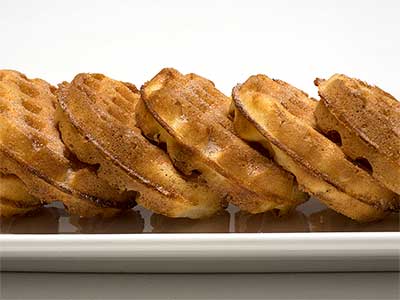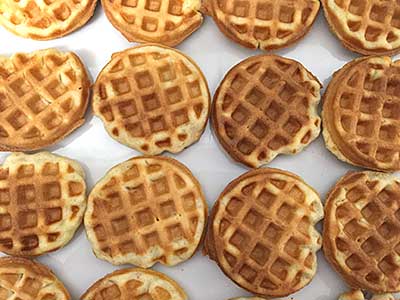May 4, 2015
Mignardise

les gaufres de Miss Leslie
(Miss Leslie’s waffles)
Another week, another waffle. My toy is taking over my life. The machine worked better this week than at any time in the past, even with a recipe that is over 175 years old. Maybe I should leave the mini-waffle maker a five-star rating on Amazon and move on to a different category of dishes?
As I said last week, I hadn’t made any traditional waffles at the time. So I started to look at waffle recipes. Modern recipes looked too complicated and had too many ingredients. So I started working my way back in history. The earliest American recipe I found without breaking a sweat is from Miss Leslie’s Directions for Cookery, In Its various Branches. I have a PDF file of the tenth edition from 1840.
After my first read of the recipe, I figured it would be easy to divide the ingredient quantities by eight and maybe be within a reasonable amount of batter for the mini-waffles. For once, all the units of measure were ones common today. No gills. No tea cups. No salt spoons. (I once had to convert the speed of light from meters per second into furlongs per fortnight, but that was a different life.) There’s always an unknown when eggs are given as unit quantities since eggs weren’t sized in Leslie’s time as they are today, and the average egg was probably much smaller. I also assume her yeast was either homemade or obtained from a local brewer. I got mine from the plastic container in my freezer.
120 ml (1⁄2 c)
whole milk
1⁄2 t
active dry yeast
1 extra-large
egg, beaten
15 g (1 T)
unsalted butter, melted
55 g (2 oz)
all-purpose flour
sugar and cinnamon mixed
1. In a small bowl heat a couple tablespoons of the milk in a microwave to about 41 °C (106 °F). Sprinkle the yeast over the surface. Set aside for about 10 minutes.
2. Whisk together the egg and the remainder of the milk. Whisk in the melted butter. Stir the milk-yeast mixture, and whisk that into the main mixture. Add the flour, and whisk until smooth.
3. Set aside at room temperature until the batter doubles in size, about an hour. Even after stirring, it should still be quite foamy.
4. Heat your mini-waffle maker.
5. When the waffle maker has come to heat, give the waffle irons a light spray of cooking oil. Working rapidly, spoon 1⁄2-T portions into the waffle patterns. Close and latch the top. Cook the waffles until the sizzling stops, about 4 minutes.
6. Remove the waffles from the irons. While still warm, sprinkle the waffles with the sugar and cinnamon mix. If necessary, cut the waffles with scissors into separate pieces and trim the edges.
7. Serve immediately, or individually freeze. Reheat defrosted waffles in a 100 °C (210 °F) oven before serving.
Yield: 24 mini-waffles.
You’ve probably already noticed that there is no sugar in the batter in the recipe above. Modern batters usually contain some sugar to aid in crispness and color. So last night I decided to see if I could determine when sugar was added to waffle recipes in America. I failed at that, but I did find an earlier Leslie recipe for waffles that contained sugar. It was in the fourth edition of her Seventy-Five Receipts for Pastry, Cakes, and Sweetmeats from 1832. So I had to try that one also.
This recipe produced a much harder waffle that could be used as a cookie. The sweetness was subtle. The cinnamon was barely perceptible. Spreading butter and more cinnamon on the hot waffle, as suggested by Miss Leslie was not an improvement.

1 extra-large
egg, beaten
80 ml (1⁄3 c)
whole milk
20 g (1-1⁄3 T)
unsalted butter, melted
20 g (1-2⁄3 T)
granulated sugar
115 g (4 oz)
all-purpose flour
1⁄8 t
ground cinnamon
1. Mix the ingredients in order. Set aside at room temperature for an hour to allow the flour time to hydrate.
2. Heat your mini-waffle maker.
3. When the waffle maker has come to heat, give the waffle irons a light spray of cooking oil. Working rapidly, spoon 1⁄2-T portions into the waffle patterns. Close and latch the top. Cook the waffles until the sizzling stops, about 4 minutes.
4. Remove the waffles from the irons. If necessary, cut the waffles with scissors into separate pieces and trim the edges.
5. Serve plain or with a little jam.
Yield: 20 mini-waffles.
If you happen to have a little buttermilk hiding in your fridge, substitute it for the whole milk in either of these recipes.
© 2015 Peter Hertzmann. All rights reserved.
